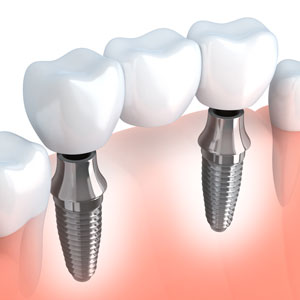Injury or Tooth Decay
Anyone who is missing one or more teeth, even at the back, due to injury or tooth decay may be a candidate for dental implants.
When a tooth is removed, the surrounding teeth begin to move or tilt, which in turn can lead to decay, gum disease, and jaw problems. There maybe a loss of muscle tone, which may result in the skin appearing ‘saggy’. Replacing the tooth into the bone with a dental implant allows the muscle to become stronger and the bone to revitalise. This allows the facial skin to expand, looking smoother.
Artificial Tooth Root
A dental implant is an artificial tooth root, a metal rod – usually made from titanium – that has an internal screw or clip. It fits directly into your jawbone the same way that roots support natural teeth. Over several months, your jawbone will fuse with the titanium rod. Dentures, crowns or bridges can be attached to the implant to replace your missing teeth.
Proceedure
Having dental implants will require at least one minor operation.
- The first step involves placing small screw-like fixtures, which can be considered your new dental roots. The gum tissue is replaced over the implant after it has been positioned precisely into the bone. The procedure is performed under local anesthesia and is generally not painful.
- The implant is then left to naturally bond to the bone for a period of three to six months. Once bone bonding is complete the joint between implant and bone is strong enough, the implant is uncovered in a second procedure and attachments made to the titanium screw that protrude slightly through the gum.
- The final treatment is the attachment of the visible tooth structure.

